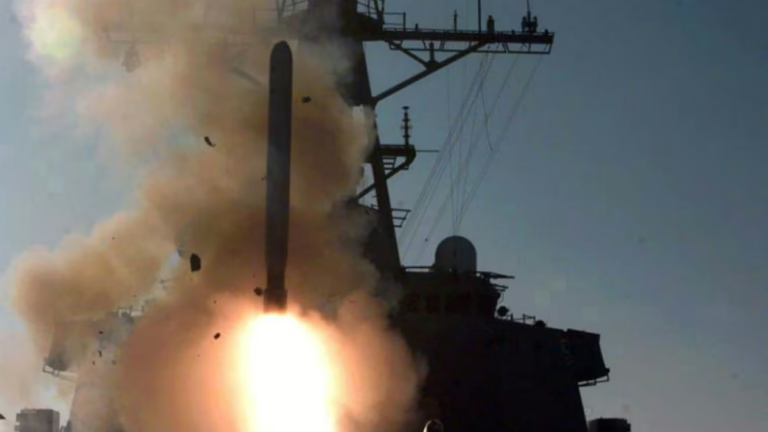Russia is closely observing Ukraine’s appeal to the United States for long-range Tomahawk missiles, which could significantly enhance Kyiv’s capacity to conduct strikes deep within Russian territory.
This request emerges amid a noticeable shift in US President Donald Trump’s approach toward supporting Ukraine in its conflict with Russia, fueled by his mounting dissatisfaction with President Vladimir Putin’s ongoing military campaign, despite their peace discussions in Alaska last August.
On Monday, Dmitry Peskov, the spokesperson for the Russian government, addressed the media, downplaying the potential impact of supplying such weapons to Ukraine. Nonetheless, he warned that the US might be crossing a critical boundary Moscow has previously defined regarding what it considers direct involvement by Ukraine’s allies in the war.
“The key issue remains: who will be responsible for launching these missiles? Will it be solely Ukrainian forces, or will American personnel be involved? Who will control the targeting decisions-the US or Ukraine?” Peskov questioned.
Moscow has consistently stated that providing targeting intelligence or data to facilitate attacks would constitute crossing a red line. It has also hinted at the possibility of resuming production of intermediate-range nuclear weapons and deploying similar missile systems within striking distance of Western nations.
Adding to the warnings, former Russian President Dmitry Medvedev cautioned via Telegram that such interference could escalate into a conflict involving weapons of mass destruction.
Below is an overview of the US position on Tomahawk missiles and the implications of potentially supplying them to Ukraine:
Ukraine’s Weapon Requests and the US Reaction
During a meeting in New York at the United Nations General Assembly last week, Ukrainian President Volodymyr Zelenskyy revealed he had formally requested Tomahawk missiles from President Trump.
Under the Biden administration, the US had previously limited Ukraine’s use of American-supplied weapons to avoid direct strikes on Russian soil, permitting attacks only on Russian forces within occupied Ukrainian regions.
However, Zelenskyy told Axios that Trump indicated Ukraine could respond in kind to Russian attacks, such as targeting energy infrastructure if Russia targeted Ukraine’s energy facilities.
US Vice President JD Vance confirmed on Fox News that the administration is actively considering Kyiv’s request for Tomahawks, with Trump expected to make the final decision.
Additionally, Keith Kellogg, the US special envoy to Ukraine, noted that the Trump administration has already authorized some deep strikes into Russian territory and emphasized that no area should be considered off-limits.

Understanding Tomahawk Missiles
Tomahawk missiles are subsonic cruise missiles with long-range capabilities, deployable from naval vessels, submarines, or land-based launchers. They can strike targets located between approximately 1,250 km and 2,500 km (777 to 1,553 miles) away.
Equipped with high-explosive warheads, these missiles are designed to penetrate fortified structures such as military bunkers. Their flight profile involves low-altitude, high subsonic speeds, enabling them to evade radar detection effectively.
Since the 1970s, the US Navy has operated Tomahawks, which are currently produced exclusively by the American defense contractor RTX.
Reasons Behind Ukraine’s Demand for Tomahawks
Kyiv has persistently sought advanced long-range missile systems to extend its strike reach into Russian territory. However, NATO allies have largely hesitated to supply such weapons, wary of escalating the conflict.
Over time, some Western nations have eased restrictions, granting Ukraine greater autonomy in deploying the weapons they provide.
In the final months of his presidency, Joe Biden relaxed limitations on missile use, partly influenced by Trump’s campaign stance against further support for Ukraine.
In May 2023, the UK began supplying Storm Shadow missiles-long-range weapons developed by Britain and France, weighing around 1,300 kg (2,866 pounds) with a range near 250 km (155 miles). By August 2024, the UK authorized Ukraine to use these missiles directly against Russian targets.
In April 2024, the US delivered Army Tactical Missile Systems (ATACMS) to Ukraine, capable of striking targets up to 300 km (186 miles) away.
Despite their capabilities, both Storm Shadow and ATACMS have shorter ranges and smaller warheads compared to Tomahawks.
To circumvent allied restrictions, Ukraine has developed indigenous drone-missile systems, such as the turbojet-powered Paliantysia drone, which reportedly can reach targets approximately 650 km (404 miles) distant.
In August, Ukraine introduced the Flamingo missile, a ground-launched system claimed to have a range of up to 3,000 km (1,864 miles), though its operational use remains unconfirmed.
Marina Miron, a defense analyst at King’s College London, noted that based on Ukrainian data, the Flamingo might surpass Tomahawks in range and destructive power. Still, she suggested Ukraine’s request for US missiles may be driven more by strategic signaling than immediate operational needs.
“Ukraine might be testing Russia’s response, aware that deploying such missiles could provoke a stronger Russian reaction,” Miron explained.
Should Ukraine acquire Tomahawks, experts believe it would markedly enhance Kyiv’s ability to target critical Russian military infrastructure deep inside Russia, including bases, supply lines, airfields, and command centers.
Keir Giles, a Russian military specialist at Chatham House, emphasized that these missiles would disrupt Russian defensive strategies, which often rely on positioning forces just beyond the reach of Ukrainian strikes.
“Tomahawks would enable deep strikes on key military sites, preventing Russia from sheltering behind frontline positions,” Giles stated.
However, Miron cautioned that while Tomahawks would inflict damage, they are unlikely to compel Russia to withdraw from Ukraine.
President Zelenskyy has also indicated that possessing such missiles might serve more as a deterrent than a tool for active use, potentially pressuring Russia toward negotiations.
“Having these weapons could increase pressure on Putin to engage in peace talks, even if we never actually launch them,” Zelenskyy told Axios.

Potential Russian Reactions to US Tomahawk Deliveries
While Russia views Western military aid to Ukraine as a serious threat, experts believe Moscow is unlikely to escalate the situation dramatically.
Despite Russia’s veiled warnings, Western nations continue to provide Ukraine with both humanitarian and military assistance.
At last week’s UN General Assembly, Russian Foreign Minister Sergey Lavrov reiterated Moscow’s stance, condemning what he called “increasingly frequent threats of force” against Russia.
“Russia has no intention of aggression but will respond decisively to any attack on its territory,” Lavrov asserted.
Keir Giles noted that Russia’s threats often serve as intimidation tactics, with Moscow exercising caution, especially regarding the US, given NATO’s collective defense commitments.
Recent Russian drone violations of NATO airspace have raised concerns about Moscow testing the alliance’s resolve, but analysts doubt these provocations will escalate into open conflict.
“Russia labels everything a red line, but nuclear escalation is not in their interest. They want to avoid confrontation with a united NATO and the US due to the catastrophic consequences,” Giles explained.

Europe’s Reaction to Russian Provocations
European leaders have remained silent on the Tomahawk missile debate but are increasingly concerned about recent Russian incursions into their airspace.
On Sunday, Poland temporarily closed part of its airspace during a Russian attack on Ukraine, following an incident on September 9 when Polish and NATO fighters shot down 20 Russian drones-the first direct engagement between NATO and Russian military assets since the 2022 invasion.
Estonia reported that three Russian MiG-31 jets armed with missiles briefly entered its airspace last week, prompting an emergency UN Security Council meeting where allies condemned Moscow’s actions.
Denmark imposed a week-long ban on drone flights after multiple sightings, including incidents that forced airport closures.
Other countries such as Romania, Latvia, Norway, Germany, and France have also reported suspicious drone activity throughout September.
German Chancellor Friedrich Merz, speaking in Düsseldorf, accused Russia of attempting to fracture European unity. Germany continues to withhold its long-range Taurus missiles from Ukraine, fearing escalation.
Merz described the current state of Russia-Europe relations as “not war, but no longer peace.”



















